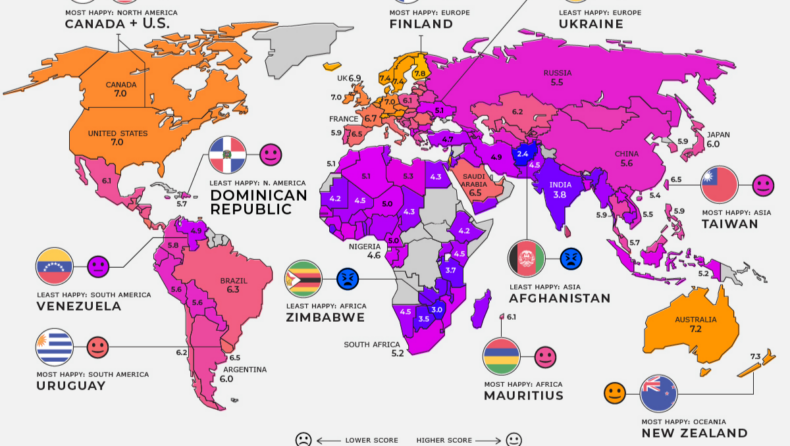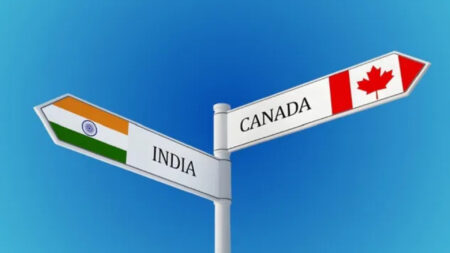As the year 2022 marks the tenth anniversary of the World Happiness Report, World Happiness Report, ranked India at 136th, among 146 countries.
The measurement is done taking subjective consideration of mainly three main well-being indicators: life evaluations, positive emotions, and negative emotions. This year India slid behind its neighbouring nation: Sri Lanka, Bangladesh, Nepal and even Pakistan, ahead of only Afghanistan which ranked at 146th out of 146 countries.
As the year 2022 marks the tenth anniversary of the World Happiness Report, World Happiness Report, ranked India at 136th, among 146 countries. The measurement is done taking subjective consideration of mainly three main well-being indicators: life evaluations, positive emotions, and negative emotions.
This year India slid behind its neighbouring nation: Sri Lanka, Bangladesh, Nepal and even Pakistan, ahead of only Afghanistan which ranked at 146th out of 146 countries.
History of the World Happiness Index
The first World Happiness Report was shown in April 2012. A report called “Defining a New Economic Paradigm: The Report of the High-Level Meeting on Well-being and Happiness” was written. It looked at evidence from the new science of happiness.
Prime Minister Jigmi Y. Thinley and Jeffrey D. Sachs led this meeting, which was led by them. UN General Assembly Resolution 66/281 was passed on June 28, 2012, and it said that every March 20th should be a day for people to be happy. The Gallup World Poll is the source of the annual happiness rankings.
Reason for India’s poor performance
India’s GDP is projected at 9.1% by MOODY’s for the financial year 2022. With India’s latest ranking in the Happiness Index, it remains the unhappy lot. Observer Research Foundation have reasoned five circumstances primarily responsible for India’s overwhelming performance. Reason label:
Reason 1: Declining incomes and unemployment
India’s 90 per cent workforce operates in the informal. Social security and income security ensures savings and resources that can act as a buffer in the face of shocks like the one levied by the bygone pandemic from which the country is still recovering.
As such, the economic burden of the pandemic was disproportionately heavier and the misery that followed was much more for the informally employed. Low-income employment also caused an aggravation to the misery.
Reason 2: Unfavorable perceptions about corruption in the country
According to Global Corruption Barometer Asia (published by Transparency International) survey, India had the highest overall bribery rate (39 per cent) and the highest rate of citizens using personal connections (46 per cent) in Asia. The survey reported (2020),
“Of the people surveyed in India, who came into contact with the police, 42% had paid bribes. The use of bribes was also rampant (41%) to obtain official documents such as identity papers. Use of personal connections was also largely made in dealings with the police (39%), procurement of identity documents (42%), and in relation to courts (38%).”
Reason 3: Lack of social support
India attained a score of 0.376 in the social support criterion. India had scored marks lower than those countries which rank below it: Zambia, Botswana, Zimbabwe among other high-ranking countries.
This comes as a shock as India is mostly considered a cultural and spiritual hub. Low points on its social support, raises more concern than it facilitates the old belief.
Reason 4: Low levels of educational attainment
Table: Percentage Distribution of workers by educational qualifications (2018–19)
| Education Level | Regular Formal | Regular Informal | RWS | Self-Employed | Casual Workers | Total |
| Not literate | 2.29 | 11.79 | 7.93 | 25.70 | 37.41 | 24.30 |
| Literate without formal education | 0.04 | 0.19 | 0.13 | 0.43 | 0.50 | 0.38 |
| Literate below Primary | 1.25 | 3.90 | 2.83 | 5.67 | 8.03 | 5.56 |
| Primary | 3.28 | 12.66 | 8.85 | 14.20 | 18.14 | 13.88 |
| Middle | 10.52 | 23.57 | 18.27 | 22.46 | 21.72 | 21.28 |
| Secondary | 10.99 | 15.00 | 13.37 | 12.99 | 8.90 | 12.09 |
| Higher Secondary | 20.16 | 14.79 | 16.97 | 10.06 | 4.24 | 10.30 |
| Graduates and above | 51.48 | 18.09 | 31.65 | 8.51 | 1.06 | 12.22 |
| Total | 100 | 100 | 100 | 100 | 100 | 100 |
Source: PLFS unit data (2018–19)
According to the table above, 87.79 per cent of the workforce has at least a high school diploma. Those with higher educational qualifications — which are a minority in India — are more likely to be employed in jobs that provide social security, a formal job contract, and other employment advantages.
In the COVID-19 era, all forms of employment from schools to government services switched to a digital platform. Those with higher educational qualifications were better placed to cope with the impending economic disruptions. Education became an important driver of life satisfaction especially so in the COVID-19 era.
Reason 5: Age composition of India’s population
In the words of late President Pranab Mukherjee,
“A narrow vision focus on economic development may have given us a better GDP and increase in per capita income but moved our focus from environmental sustainability, social welfare, emotional and mental wellbeing of our people… The quest for happiness is closely tied to the quest for sustainable development which is a combination of social inclusion and environmental sustainability.”
India’s demography is predominantly young, about 67 per cent of India is in the age -group 15–64 years. Given the unemployment levels in the country, the fact which was mostly celebrated as an opportunity to reap demographic dividends has now turned into a national liability.
The Happiness Index ranking over the past years indicates a deterioration for India. The present year ranked India at 136th among 146 countries.
In 2021, it had ranked 139th among 149 countries. In 2020, India’s rank was 144th, while in 2019 India was ranked 140th, In 2018 it ranked 133rd and ranked 122nd in 2017. India was ranked 118th and 117th out of 157 and 158 countries respectively in the 2016 and 2015 reports.
With its GDP projected to reach a double-digit figure percentage, India must claim success in its happiness index too to attain wholesome growth with the development of all the stretches of the society.
Published By : Revathy G Sanal
Edited By : Subbuthai Padma













